Jean's Leiser section is now ready and listed under the 'Other Publishers - German' header. EFSP salutes this milestone with five posts presenting our favourite postcards by Verlag Hermann Leiser. Today the numbers 0-2000.

German postcard by Verlag Hermann Leiser, no. 58.
Danish actor and director Robert Dinesen (1874-1972) made his film debut in Afgrunden/The Abyss (1910) as Asta Nielsen's fiancee. One year later, he directed the successful circus drama De fire djaevle/The Four Devils, in which he also played the lead. It launched a trend of sensational circus dramas, and Dinesen became one of the greatest stars of both the Scandinavian and the German silent cinema.
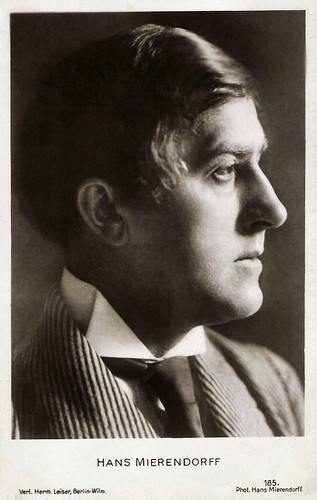
German postcard by Verlag Hermann Leiser, Berlin-Wilm., no. 185. Photo: Hans Mierendorff.
Hans Mierendorff (1882-1955) was a German stage and film actor and film director. From 1916 he appeared as the gentlemen-detective Harry Higgs, cashing in on the popular trend of German detective films at the time. Mierendorff played in over 100 films.

German postcard by Verlag Hermann Leiser, Berlin-Wilm., no. 220. Photo: Atelier Elite, Berlin.
Ernst Rückert (1886-1950) was a German stage and screen actor. In the 1910s he was a popular film actor, while in the mid-1920s he starred in so-called Prussian films.
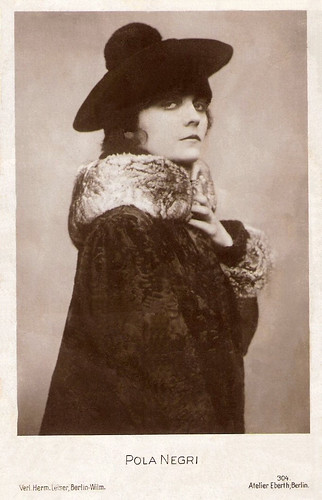
German postcard by Verlag Hermann Leiser, Berlin-Wilm., no. 304. Photo: Atelier Eberth, Berlin.
Polish film actress Pola Negri (1894-1987) achieved notoriety as a femme fatale in silent films between the 1910s and 1930s.
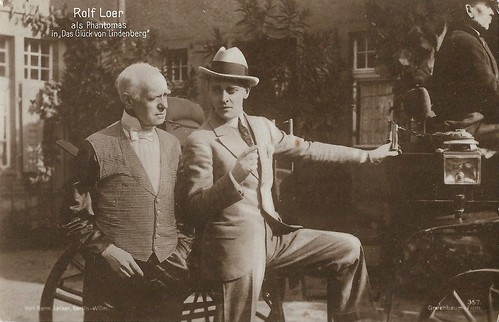
German postcard by Verlag Hermann Leiser, Berlin, no. 357. Photo: Greenbaum-Film. Rolf Loer as Phantomas in Das Glück von Lindenberg (Adolf Gärtner, 1918). The film was one of the episodes of the German Phantomas series (1916-1920).
Rolf Loer, real name Lawrence F. Koehler, also Rolf Lör or Rolf Loehr (1892-1964) was a German-American actor, violinist and music teacher. In the late 1910s, he peaked in German silent films as the character Phantomas.

German postcard by Verlag Hermann Leiser, Berlin-Wilm., no. 403. Photo: Nordische Foto-Kunst Braae.
Lya Mara (1897-1960?) was one of the biggest stars of the German silent cinema. Her stardom was even the subject of a novel, which was published in 100 episodes between 1927 and 1928. Her career virtually ended after the arrival of sound film.
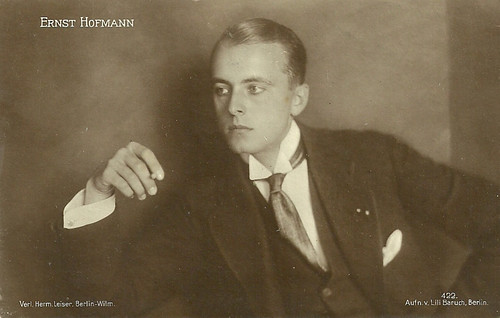
German postcard by Verlag Hermann Leiser, Berlin-Wilm., no. 422. Photo: Lili Baruch, Berlin.
German actor Ernst Hofmann (1890-1944) was one of the most attractive actors of the German silent cinema. in the 1910s He was the producer and star of Der Knabe in Blau (1918), the first film by legendary director Friedrich Wilhelm Murnau.
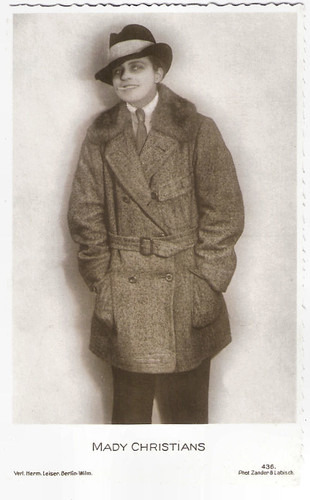
German postcard by Verlag Hermann Leiser, Berlin-Wilm., no. 436. Photo: Zander & Labisch.
Austrian-born stage actress Mady Christians (1892-1951) was a star of the German silent cinema and appeared in Austrian, French, British and Hollywood films too.

German postcard by Verlag Hermann Leiser, Berlin, no. 501. Photo: Zander & Labisch.
Lu L'Arronge (1902-1991) was a German film actress and producer, who between 1917 and 1920 mostly starred in her own productions, impersonating the type of the Backfisch.
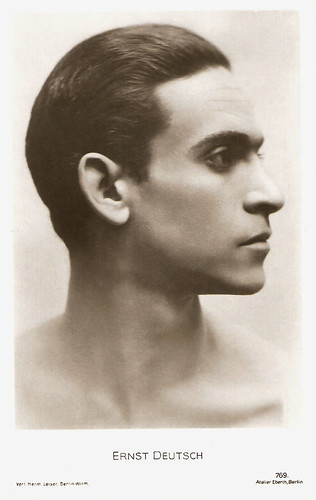
German postcard by Verlag Herm. Leiser, Berlin-Wilm., no. 769. Photo: Atelier Eberth, Berlin.
Ernst Deutsch (1890-1969) was an Austrian actor who acted in 42 silent films. He starred in such German Expressionist films as Der Golem, wie er in der Welt kam (1920), and Von morgens bis mitternachts (1920). In 1938 the Jewish actor moved to the USA and worked in Hollywood.
The History of Hermann Leiser
Who was Hermann Leiser? Information relating to Verlag Hermann Leiser is sparse. Jean Ritsema found in her research a close relationship with another publishing firm, Verlag Louis Blumenthal. First, Louis Blumenthal operated solo. Then followed a multi-year partnership between Blumenthal and Hermann Leiser. Finally, it was a solo operation by Hermann Leiser.
Jean discovered that Louis Blumenthal started in Berlin as a merchant at Mohrenstraße 17/18. By 1880, he had expanded to book printing, the paper trade, leather goods, writing materials and office supplies, still at the same address. Blumenthal's residence was nearby, at Mohrenstraße 15. In 1884, the business was relocated to Leipzigerstraße 38, the address that is printed with the text 'Verlag Louis Blumenthal' on early postcards. The firm remained at this address for the duration of Blumenthal's association with it.
Around 1898, Blumenthal was joined by Hermann Leiser in the ownership of the business at Leipzigerstraße, a partnership which lasted for a decade. Around 1909 Hermann Leiser moved to Olivaer Platz 4. In a 1909 advertisement in the Allgemeine Musik Zeitung, he announced the availability of "3000 Portratkärten, Olivaerplatz 4, vorm. Louis Blumenthal". Correspondingly, a number of cards are marked "Verlag Hermann Leiser vormals Louis Blumenthal".
The 1911-1913 address books list Leiser's business on Olivaerplatz 4, with the description of Porträtkarten. At some point, the publisher's mark on the postcards was changed to Verlag Herm. Leiser (in varying forms), dropping the reference to Blumenthal. A final move for Leiser is listed in the 1914 address book which provides a location at Rüdesheimer Platz 3 where Leiser remained through 1931. In many of the later years' entries, his business is described as a "Kaufmann" (merchant), rather than a publisher of Porträtkarten.
Jean Ritsema found it difficult to find a date for when Blumenthal's involvement with postcards began. She discovered a 1903 advertisement in the Monatsschrift für das deutsche Geistesleben, in which Blumenthal's card inventory already numbered over 1000. It also is difficult to know when Leiser's involvement with postcards ended. His listing in the 1929/30 and 1931/32 'Jüdisches Adressbuch for Gross-Berlin' came shortly before the forced transfer of Jewish-owned property to non-Jews in Nazi Germany from 1933 to 1945. The circumstances of Leiser's business and life at that time are unknown. However, in a 1998 monograph by Corinna Müller and Harro Segeberg, 'Die Modellierung des Kinofilms' references the takeover of Leiser by Ross Verlag, stating: 'In Berlin, the Hermann Leiser company began to monopolise the star postcard business. Leiser later became the property of Ross-Verlag, which then also published numerous film star series and was eventually replaced itself in the 1930s by the Ufa-postcard service'.
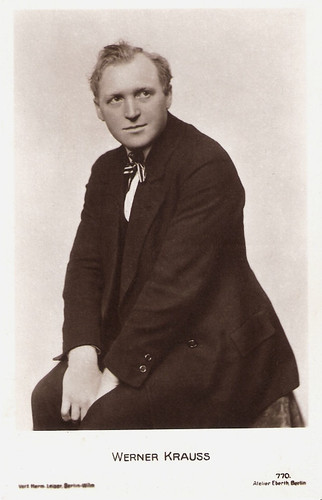
German postcard by Verlag Hermann Leiser, Berlin- Wilm., no. 770. Photo: Eberth, Berlin.
German stage and film actor Werner Krauss (1884-1959) became a worldwide sensation as the demonic Dr. Caligari in the classic of the German expressionist cinema, Das Kabinett des Doktor Caligari/The Cabinet of Dr. Caligari (1919). He appeared in several silent masterpieces, but his magnificent film career was later overshadowed by his appearance in one of the most notorious propaganda films of the Third Reich.
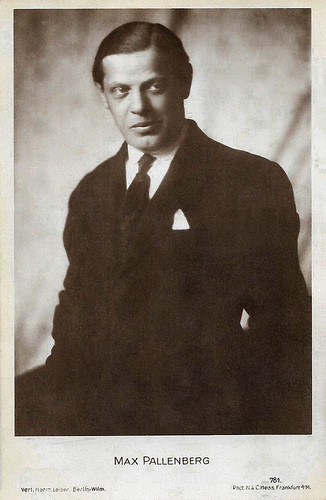
German postcard by Verlag Hermann Leiser, Berlin-Wilm., no. 781. Photo: N. & C. Hess, Frankfurt a.M.
Max Pallenberg (1877-1934) was an Austrian singer, actor and comedian. He was one of the most important comedians of his time and often played under the direction of Max Reinhardt. Although Pallenberg was successful as a stage comedian, he only incidentally accepted roles in films.

German postcard by Verlag Hermann Leiser, Berlin-Wilm, no. 842. Photo: Imperial-Film.
Grete Lundt aka Grete Lund (1892-1926) was an Austrian stage and screen actress, who played in Austrian and German silent films.
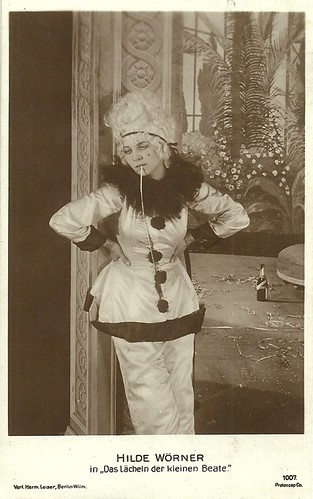
German postcard by Verlag Hermann Leiser, Berlin-Wilm., no. 1007. Photo: Protoscop Co. Hilde Wörner in Das Lächeln der kleinen Beate (Georg Schubert, 1919).
Hilde Wörner (1895-1963) was a German stage and film actress, who also worked as a filmmaker. She appeared mainly in silent films, had her own series and her most notable film was Ernst Lubitsch’s Die Flamme (1922).
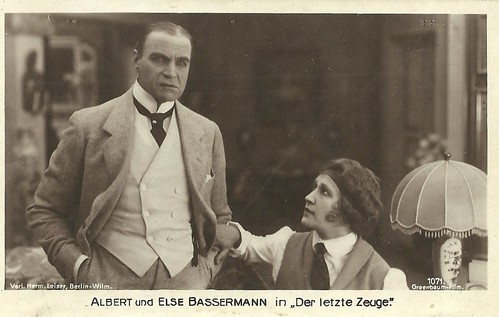
German postcard by Verlag Hermann Leiser, no. 1071. Photo: Greenbaum-Film. Albert and Else Bassermann in Der letzte Zeuge/The Last Witness (Adolf Gärtner, 1919).
Albert Bassermann (1867–1952) was one of the first great German stage actors who worked for the cinema. In 1933 he fled the Nazi regime and became an Oscar-nominated stage and film actor in the US.
Else Bassermann, née Elisabeth Sara Schiff (1878-1961) was a German stage and screen actress, who in 1908 married renowned stage actor Albert Bassermann and often performed together with him on stage. When he started to play in the film, she accompanied him.

German postcard by Verlag Hermann Leiser, Berlin-Wilm., no. 1202. Photo: Atelier Lendvai-Dircksen.
German ‘dynamite’ director, actor, producer and screenwriter Harry Piel (1892-1963) made over 150 sensational films full of explosions and stunts.
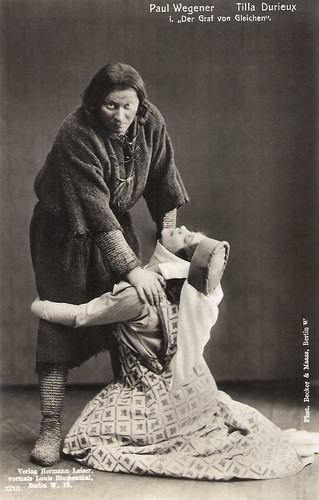
German postcard by Verl. Hermann Leiser, Berlin-Wilm., no. 1210. Photo: Becker & Maass, Berlin. Paul Wegener and Tilla Durieux in the stage production of 'Der Graf von Gleichen' by the Berliner Kammerspiele in 1909.
German actor, writer and film director Paul Wegener (1874-1948) is one of the true fathers of the horror and fantasy genre, particularly remembered for his three silent films centred around the Jewish legend of the Golem. Wegener was one of the pioneers of German cinema who realized the potential of the new medium and used the possibilities of cinematic trick photography as a method for presenting fantastic tales in a serious matter.

German postcard by Verlag Hermann Leiser, Berlin, no. 1233. Photo: Becker & Maass, Berlin. Paul Wegener in the play 'Der Arzt am Scheideweg' (The Doctor's Dilemma) by George Bernhard Shaw.
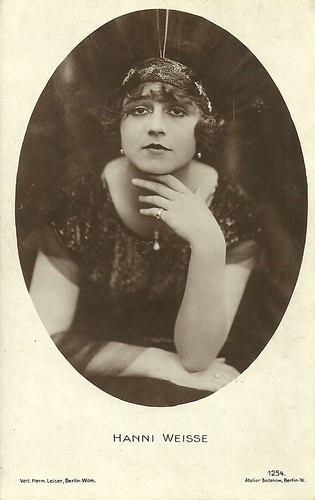
German postcard by Verlag Hermann Leiser, no. 1254. Photo: Atelier Badekow, Berlin.
German actress Hanni Weisse (1892-1967) belonged to the great film divas of the early German silent film. She was able to maintain her stardom till the 1920s.
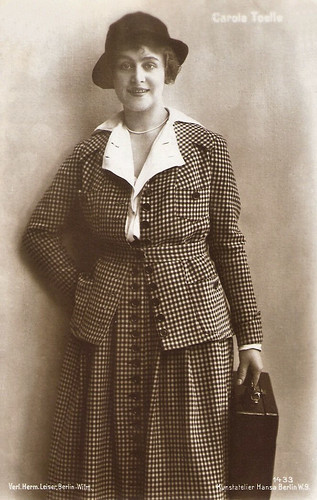
German postcard by Verlag Hermann Leiser, Berlin-Wilm., no. 1433. Photo: Filmatelier Hansa.
Carola Toelle (1893-1958) was a German actress, in particular in German silent cinema of the late 1910s and early 1920s.
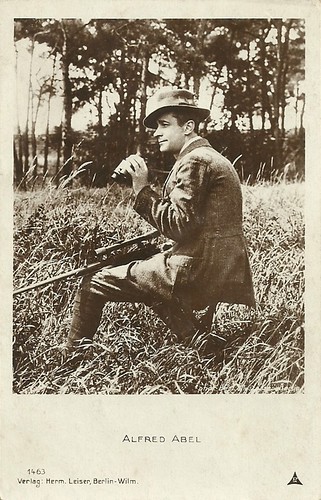
German postcard by Verlag Hermann Leiser, no. 1463. Photo: Berliner Illustrierte, Berlin. 1910s.
Alfred Abel (1879-1937) played in over 140 silent and sound films between 1913 and 1938. He is best known as the industrial Fredersen in Fritz Lang's Metropolis (1927).
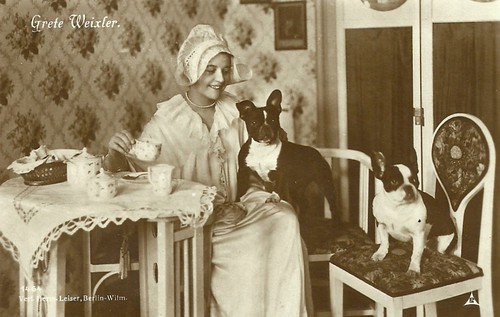
German postcard by Verlag Hermann Leiser, Berlin, no. 1464. Photo: Pm.
Grete Weixler (ca. 1900- after 1922) was a German actress of the silent cinema. From 1914 on, she appeared in secondary roles in melodramas by directors like Carl Boese, Friedrich Zelnik and Lupu Pick.
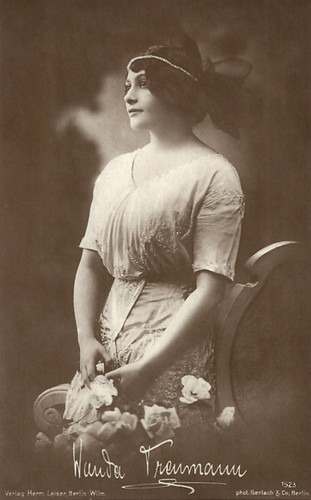
German postcard by Verlag Hermann Leiser, Berlin-Wilm., no. 1523. Photo: Gerlach & Co., Berlin.
Wanda Treumann (1883-1963) was a German actress and film producer. Together with Viggo Larsen, she produced many films in the 1910s, in which she also often had the female lead.

German postcard by Verlag Hermann Leiser, Berlin-Wilm., no. 1645. Photo: Willinger.
German actress, writer and producer Hedda Vernon (1886-1925) appeared in more than 60 films of the early silent period. During the 1910s she was such a popular film star that she got her own Hedda-Vernon serial.
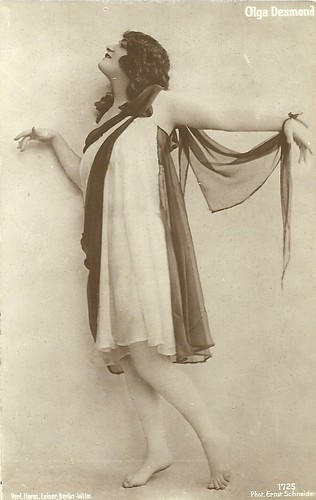
German postcard by Hermann Leiser, Berlin-Wilm., no 1725. Photo: Ernst Schneider. Collection: Didier Hanson.
Olga Desmond (1890-1964) was a German dancer and actress. Desmond was the 'heroine of living pictures' and became one of the first to promote nudity on the stage. From 1916 through 1919 she appeared in various films.

German postcard by Verl. Herm. Leiser, Berlin-Wilm., no. 1746.
Albert Paulig (1873-1933) was a popular actor in the German silent cinema of the 1910s and 1920s.

German postcard by Verlag Hermann Leiser, Berlin-Wilm., no. 1859. Photo: Hugo Erfurth, Dresden.
Maria Fein (1892-1965) was an Austrian actress and theatre director, who peaked as a film star between 1916 and 1919.

German postcard by Verlag Herm. Leiser, Berlin-Wilm., no. 1860. Photo: Zander & Labisch. Theodor Loos in the play 'König Salomon' (King Solomon).
Theodor Loos (1883-1954) was a German stage and screen actor between the 1910s and the 1950s. He became famous for his parts in Fritz Lang’s German films.
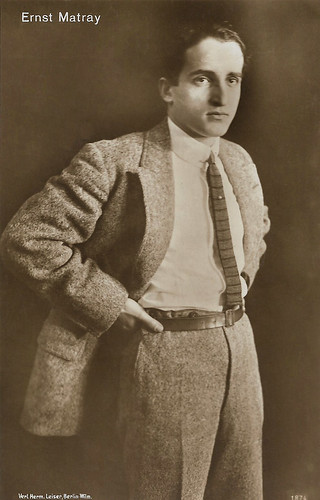
German postcard by Verlag Hermann Leiser, Berlin-Wilm., no. 1874.
Ernst Matráy (1891-1978) was a Hungarian dancer, choreographer, actor and film director. In Berlin, he worked with Max Reinhardt and Ernst Lubitsch. Together with his wife Maria Solveg, he later did the choreography for some classic Hollywood films.

German postcard by Verlag Hermann Leiser, Berlin-Wilm., no. 1880. Photo: Fritz Richard. Emil Jannings in 'Kollege Crampton' by Gerhart Hauptmann.
If Weimar cinema had one film star, then it was Emil Jannings (1884-1950) for sure. He was a great actor in the silent era and won the first Oscar for Best Actor. Priceless are his performances as Louis XV in Lubitsch's Madame Dubarry (1919), as the doorman in Murnau's Der Letzte Mann/The Last Laugh (1924) and as Mephisto in Faust (1926), as the jealous acrobat in Dupont's Variété/Variety (1925) and as the professor in Von Sternberg's Der blaue Engel/The Blue Angel (1930).
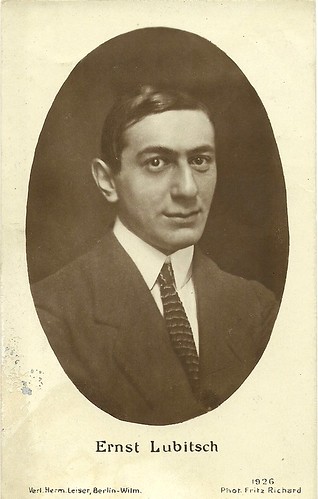
German postcard by Verlag Hermann Leiser, Berlin-Wilm., no. 1926. Photo: Fritz Richard. Collection: Didier Hanson.
Ernst Lubitsch (1892-1947) was a German-American actor, screenwriter, producer and film director. His urbane comedies of manners gave him the reputation of being Hollywood's most elegant and sophisticated director; as his prestige grew, his films were promoted as having ‘the Lubitsch touch.’ He was nominated three times for the Oscar for Best Director and in 1947, he received an Honorary Academy Award.
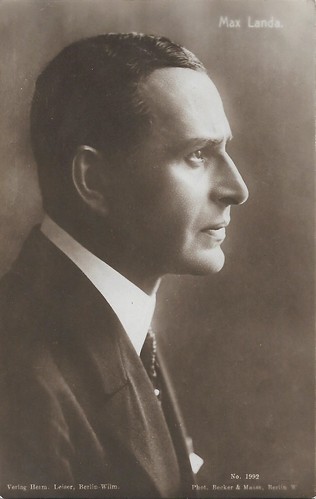
German postcard by Verlag Hermann Leiser, Berlin-Wilm., no. 1992. Photo: Becker & Maass.
Austrian actor Max Landa (1880-1933) started his career in silent films opposite Asta Nielsen. Later he starred as the cosmopolitan gentleman-detective Joe Deebs in the very popular silent serial.
To be continued tomorrow!
Source: Jean Ritsema (Ross Postcards).
No comments:
Post a Comment